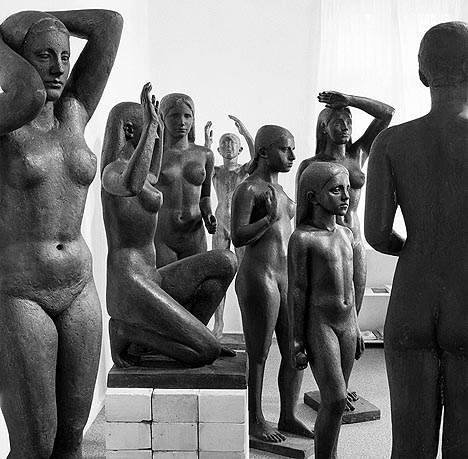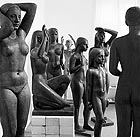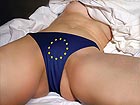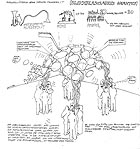
translated and summarized by: Liz Wollner-Grandville,
English summary September 29 - October 5
Landesgalerie am OÖ Landesmuseum: Political sculpture – Barlach, Kasper, Thorak, Wotruba
Antihero tales
The question concerning if and how Nazi conformist paintings and sculptures (Nazi art) should be presented, is a controversial topic. The Arno Becker exhibit in Schwerin, for example, can definitely be regarded as a lesson on how it should not be done.
At first sight it may seem odd that works by Ernst Barlach and Fritz Wotruba are shown side by side with works by the propagandist Josef Thorak or Ludwig Kasper at the exhibit "Political sculpture". In any case this exhibit, curated by an large team of scientists, turned out to be an equally informative as well as instructive overview - allowing no room at all for applause from the wrong side.
Large format photos give an impression of how the works must have presented themselves in a historical context, and written excerpts offer interesting details on the artist’s themselves; they inform us that Thorak divorced his wife because she was Jewish, that Barlach fought against the Nazi-regime until his death, that Ludwig Kasper was a member of a heterogeneous studio group, and, like Wotruba, earned a large amount of money during the days of Socialist predominance in Vienna. Only in the last two rooms of the exhibit does it become clear how, after 1945, the artist’s biographies affect each other: how, for example, Barlach became an East German hero, and how a Wotruba-relief can suddenly find itself next to a sculpture by Thorak.
More exhibits of this kind would be desirable. They are able to express so much more about decades of Austrian and German art history than sundry monographic tales about heroes.
Landesgalerie am OÖ. Landesmuseum
4010 Linz, Museumstrasse 14, until 16. 11. 2008
www.landesgalerie.at
Tiroler Künstlerschaft / Kunstpavillon: Tanja Ostojic – Integration Impossible?
Politically consequent
“Looking for a husband with an EU passport” is the title of an advertisement showing a photo of the naked Serbian artist Tanja Ostojic. She “sells” herself on the EU marriage market and thereby makes a clear statement about the practice of intermarriages between EU and non-EU citizens, and relentlessly uncovering its migration-political dimension. A fellow artist from Germany turns out to be a suitable marriage partner. Their first encounter in Belgrade is staged as a public performance. The couple marries, Ostojic applies for a visa, moves to Düsseldorf, attends the required German lessons; in short: she treads the path, which is oftentimes the only way for women into the EU and whose gloomy perspective frequently ends in prostitution or human trafficking. In 2005, Ostojic organizes a divorce party, which takes place during a vernissage.
This project, which includes photos, videos, and letters, and is shown in the exhibit “Integration Impossible?” is among Ostojic’s (born 1972 in Uzice, Serbia) most famous works. The most radical reaction to her photograph titled “After Courbet” (referring to the “Origin of the World” 1866 by Gustave Courbet) occured in Vienna in 2005. In this photograph a woman’s lower abdomen is shown clad in EU underpants. The photo had to be taken down after only two days. With “After Courbet” Ostojic focused on viewing the (im)possibilities of belonging to the EU elite-group from a feministic perspective: sex not only sells well, it is oftentimes the entrance fee. The border between performance art and political activism becomes blurred in many of Ostojic’s works, who often draws from her own experience: when her visa application to Austria was rejected (she had been invited by an Austrian art institution in 2000) she successfully attempted an “Illegal Border Crossing”. In her powerful video installation “Naked Life”, Ostojic is shown reading reports about the deportation of the Roma and Sinti, the largest minority groups in Europe. While reading the horrid facts about their deportation, the artist takes of one piece of clothing after the other: all that counts is naked survival.
Tiroler Künstlerschaft / Kunstpavillon
6020 Innsbruck, Rennweg 8a, until 8. 11. 2008
www.kuenstlerschaft.at
Pinakothek der Moderne: Female Trouble – The camera as a mirror and stage of female projection
Art and anxiety
Tracy Moffat produces art works, which would be inconceivable without their female perspective. Moffat, an Australian of Aboriginal descent, and her view on how the Commonwealth state deals with its indigenous population offer additional material for her picture world.
“Scarred for Life” is the title of one of her most well known photo series (1994). She combines each photo with a commentary; through this image-text combination a third view develops for the subaltern, for childhood, and the suppression of sexuality, as well as the abuse, which might have followed.
Only three works from this cycle are hung here, three in which girls are the main theme. Another part of “Scarred for Life” would have been “Doll Birth”, showing a boy giving birth to a doll while his male friend takes on the role of the midwife. The accompanying text explains that the mother was so angry that she prohibited her son from ever playing with the neighbours’ boy again. “Doll Birth” is not shown, mainly because the show obviously concentrates on only presenting women or at least people who look like women.
They are all here: Cindy Sherman and Nan Goldin, Pipilotti Rist and Mathilde ter Heijne, Valie Export and Birgit Jürgenssen, Claude Cahun and Julia Margaret Cameron and Urs Lüthi and Jürgen Klauke.
Thomas McEvilley wrote a book in 1991 about art and anxiety titled “Art and discontent”; quite a difference to the German title, which could be translated as “Art and dissatisfaction”. Dissatisfaction: that is exactly what you feel in this exhibit.
Pinakothek der Moderne
80333 München, Barer Strasse 40, until 26. 10. 2008
www.pinakothek.de
Augarten Contemporary: Augustin Luser – Clouds of Action
Biology of success
As the title of this exhibit Handlungswolken – Clouds of Action implies, Constantin Luser confronts the onlooker with the dissolution of a concrete reality into its diffuse components consisting of frequencies and electromagnetic oscillations. His drawings guide us into the world of his (un) consciousness.
His Vibrosaurus, almost ten metres long, is the main object of this exhibit. It consists of brass tubes, which the artist obtained from trumpets, trombones, tubas, and French horns and which can be played by up to 30 wind players. The idea of the Spheric Carousel seems to be continued into the realms of biology. In one of his drawings for the Vibrosaurus Luser depicts the figure in waves with a strong similarity to the wave structure of a Fourier analysis. The animal body is brass tone.
This sculpture is an impressive aesthetic manifestation of the realisation that even matter exists in a wave structure – something already discovered by Louis de Broglie in 1927. When the object is played one can relate to the frequencies of the formation a large (living) body consists of. The installation Augenfahrt – Eye trip, is a walk-in rectangular form with rounded corners, and a dark, black interior, in which only a single ray of light is directed at a small white drawing. Is this the 3D transformation of the interior view of the artist’s consciousness, which is otherwise to be seen as pencil drawings in the exhibit? This time he is also showing drawings in combination with painting – colourful works, on which electromagnetic forces seem to vibrate.
The exhibit also presents Luser’s large white lacquered rounded wooden plates, with his Lines of Thought, resembling mapped out landscapes. They include meticulously detailed maps, fineliner-pen drawings of human figures, details of architectural design and landscapes, oftentimes connected by lines, waves or circles. Text fragments allude to the artist’s socio-political, scientific or personal thoughts: “So that this exhibition will be a huge success, yes, yes” can be read in tiny letters in one of his drawings. Yes, of course!
Augarten Contemporary
1020 Vienna, Scherzergasse 1a, until 14. 12. 2008
www.atelier-augarten.at
Mehr Texte von translated and summarized by: Liz Wollner-Grandville


 Teilen
Teilen




